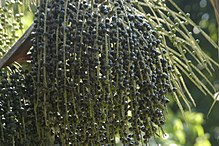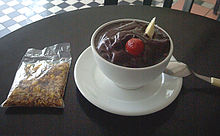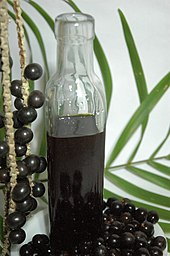Açaí palm
| Açaí palm | |
|---|---|

| |
| A tree at the Lauro Sodré Palace in Brazil | |
| Scientific classification | |
| Kingdom: | Plantae |
| Clade: | Tracheophytes |
| Clade: | Angiosperms |
| Clade: | Monocots |
| Clade: | Commelinids |
| Order: | Arecales |
| Family: | Arecaceae |
| Genus: | Euterpe |
| Species: | E. oleracea
|
| Binomial name | |
| Euterpe oleracea | |
| Synonyms[1] | |
| |
The açaí palm (
The species is native to eastern
Name
The common name comes from the Portuguese adaptation of the Tupian word ĩwasa'i, meaning "[fruit that] cries or expels water".[6] The importance of the fruit as a staple food in the Amazon River delta gives rise to the local legend of how the plant got its name. The folklore says that chief Itaqui ordered all newborns put to death owing to a period of famine. When his own daughter gave birth and the child was sacrificed, she cried and died beneath a newly sprouted tree. The tree fed the tribe and was called açaí because that was the daughter's name (Iaçá) spelled backwards.[7]
Its
Fruit

The fruit, commonly known as açaí or açaí berry,
Cultivation
There are two harvests: one is normally between January and June, while the other is between August and December, producing larger volumes.[11] In 2022, the state of Pará, which accounts for 90% of Brazil's total açaí economy, produced 8,158 tonnes (17,985,000 lb) of açaí berries, generating US$26 million in revenue.[12] The 2022 production was 209 times greater than the volume produced in 2012.[12]
Child labor concern
Children as young as 13 years old are employed as laborers to harvest the fruit, using machetes to clear paths in the rainforest, and climbing trees up to 70 feet (21 m) tall without harnesses to collect berries in the canopy, a process leading to falls and severe injuries in some children.[12]
Cultivars
Few named
- Branco ("White") is a rare variety local to the Amazon recessive gene since only about 30% of 'Branco' palm seeds mature to express this trait.[13]
- BRS-Pará was developed in 2004 by the Brazilian Agricultural Research Agency. The pulp yield ranges from 15% to 25%.[14]
- BRS Pai d'Égua is the newest cultivar developed by the Brazilian Agricultural Research Agency.[15]
Anthocyanins
A powdered preparation of
Nutritional content
A powdered preparation of freeze-dried açaí fruit pulp and skin was reported to contain (per 100 g of dry powder) 534
Marketing
In the 1980s, the Brazilian
Scams
In the early 2000s, numerous companies advertised açaí products online, with many ads featuring
According to the Washington, D.C.-based
The FTC handed down an $80 million judgement in January 2012 against five companies that were marketing açaí berry supplements with fraudulent claims that their products promoted
Production

Brazil is a major producer, particularly in the state of Pará, which alone in 2019 produced more than 1.2 million tons of açaí, an amount equal to 95% of Brazil's total.[34]
Uses
As a food product
Fresh açaí has been consumed as a dietary staple in the region around the
In a study of three traditional

Açaí na tigela (known in English as açaí bowl) is a Brazilian dessert made from frozen açaí berry purée, served in a bowl and topped with other fruit and granola.[37][38]
Dietary supplement
As of 2008, no açaí products have been evaluated by the
As of 2009, there is no scientific evidence that açaí consumption affects body weight, promotes weight loss or has any positive health effect.[39]
Açaí oil

Açaí oil is suitable for cooking or as a
The oil compartments in açaí fruit contain
Other uses
Leaves of the palm may be made into hats, mats, baskets, brooms and roof thatch for homes, and trunk wood, resistant to pests, for building construction.
Comprising 80% of the fruit mass, açaí seeds may be ground for livestock food or as a component of organic soil for plants. Planted seeds are used for new palm tree stock, which, under the right growing conditions, can require months to form seedlings.[42][44] Seeds may become waste in landfills or used as fuel for producing bricks.[45]
Research
Orally administered açaí has been tested as a
Gallery
-
A grove of açaí palms in Brazil
-
An açaí harvest
-
Japanese açaí candy
See also
References
- ^ "Synonyms for Euterpe oleracea Mart., Hist. Nat. Palm. 2: 29 (1824)". Royal Botanic Gardens, Kew, UK. 2017.
- ^ "acai". Oxford English Dictionary (Online ed.). Oxford University Press. (Subscription or participating institution membership required.)
- ^ "Palm trees" (PDF). The Food and Agriculture Organization of the United Nations. Archived (PDF) from the original on 18 May 2019.
- ISBN 9780231129077.
- ^ S2CID 25276291.
- ^ Ferreira, A. B. H. (1986). Novo Dicionário da Língua Portuguesa (2nd ed.). Rio de Janeiro: Nova Fronteira. p. 19.
- ^ "Acai – What is it and Where Does it Come From?". International Business Times. 10 September 2009. Retrieved 20 June 2018.
- ISBN 978-1-4087-0615-2.
oleraceus, holeraceus = relating to vegetables or kitchen garden
- ^ Whitney, William Dwight (1899). The Century Dictionary and Cyclopedia. Century Co. p. 2856.
L. holeraceus, prop. oleraceus, herb-like, holus, prop. olus (oler-), herbs, vegetables
- PMID 19857637.
- ^ a b "Worldwide demand for açaí is growing". Fresh Plaza. Archived from the original on 31 July 2017. Retrieved 1 May 2017.
- ^ a b c Vargas Jones J (13 March 2024). "Children in Brazil are climbing 70-foot-high trees so you can eat açaí berries". CNN. Retrieved 13 March 2024.
- ^ DuVal, A (2010). "Açaí Branco: Maintaining Agrobiodiversity through a Local Seed System in the Amazon Estuary" (PDF). Tropical Bulletin: Yale University Tropical Resources Institute. 29.
- ^ "Cultivar de açaizeiro BRS Pará – Portal Embrapa". www.embrapa.br. Retrieved 20 December 2018.
- ^ Brazilian Agricultural Research Agency
- ^ Simon PW (1996). "Plant Pigments for Color and Nutrition". Vegetable Crops Research Unit, Agricultural Research Service, U.S. Department of Agriculture, Department of Horticulture, University of Wisconsin, Madison, WI.
- S2CID 21174667.
- S2CID 10683560.
- PMID 17157175.
- PMID 15019969.
- ^ Scientific Opinion on the substantiation of health claims related to various food(s)/food constituent(s) and protection of cells from premature aging, antioxidant activity, antioxidant content and antioxidant properties, and protection of DNA, proteins and lipids from oxidative damage pursuant to Article 13(1) of Regulation (EC) No 1924/20061 Archived 7 November 2021 at the Wayback Machine, EFSA Panel on Dietetic Products, Nutrition and Allergies (NDA)2, 3 European Food Safety Authority (EFSA), Parma, Italy, EFSA Journal 2010; 8(2):1489
- ^ "Flavonoids". Linus Pauling Institute, Micronutrient Information Center, Oregon State University. 2015. Retrieved 8 June 2015.
- PMID 15640486.
- S2CID 94388806.
- ^ PMID 17061839.
- ^ a b c d Colapinto, John (30 May 2011). "Strange Fruit". The New Yorker.
- ^ Ellin, Abbey (12 March 2009). "Pressing Açaí foraçaí Answers". The New York Times.
- ^ a b James, SD (12 December 2008). "'Superfood' açaí may not be worth price: Oprah's Dr. Oz says açai is healthy but no cure-all; Dieter feels ripped off". ABC News. Archived from the original on 19 December 2008. Retrieved 30 December 2008.
- ^ "Oprah is coming after bad Internet Marketers". Adotas. Archived from the original on 1 July 2010. Retrieved 10 September 2009.
- ^ "AG warns about deceptive weight loss supplement offer". King5 News. Archived from the original on 31 August 2009. Retrieved 9 September 2009.
- ^ Colapinto, John. "Strange Fruit". The New Yorker. Retrieved 14 May 2021.
- ^ "Marketers of acai products fined $1.5 million for false claims and unfair billing". Consumer Reports. 9 January 2012. Retrieved 2 November 2017.
- ^ "Internet Marketers of Acai Berry Weight-Loss Pills and "Colon Cleansers" to Pay $1.5 Million to Settle FTC Charges of Deceptive Advertising and Unfair Billing". Federal Trade Commission. 9 January 2012. Retrieved 2 November 2017.
- ^ Jorge Sauma; Caio Maia (15 March 2019). "Caminhos do açaí: Pará produz 95% da produção do Brasil, fruto movimenta US$ 1,5 bi e São Paulo é o principal destino no país". Globo (in Portuguese). Retrieved 13 March 2022.
- . Retrieved 1 May 2017.
- S2CID 150562421.
- ^ Aislyn Greene (20 June 2015). "The Surprising History of the Açaí Bowl". AFAR Media. Retrieved 10 July 2023.
- ISSN 0362-4331. Retrieved 10 July 2023.
- ^ Center for Science in the Public Interest (23 March 2009). "CSPI Warns Consumers about Web-Based Açai Scams". CSPI. Retrieved 2 September 2012.
- ^ PMID 18522407.
- PMID 17824205.
- ^ a b Silva, S. & Tassara, H. (2005). Fruit Brazil Fruit. São Paulo, Brazil, Empresa das Artes
- ^ Dyer, A. P. 1996. Latent energy in Euterpe oleracea. Biomass Energy Environ., Proc. Bioenergy Conf. 9th.
- PMID 6727398.
- ^ Cheeseman, G-M. (December 2010). "How sustainability is embedded in Sambazon". The Guardian. Retrieved 1 May 2017.
- PMID 15062934.
- ISSN 0363-8715.
- PMID 15030208.
Further reading
- Craft P, Riffle RL (2003). An encyclopedia of cultivated palms. Portland, Oregon, United States: Timber Press. ISBN 0-88192-558-6.
- Nicholas Gill. "How Açaí Helped Save Amazonian Forests". NewWorlder.




